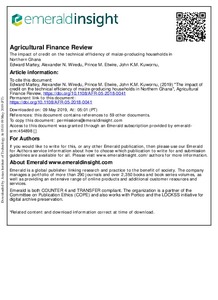| dc.contributor.author | Martey, E. |
| dc.contributor.author | Wiredu, A. |
| dc.contributor.author | Etwire, Prince Maxwell |
| dc.contributor.author | Kuwornu, J.K.M. |
| dc.date.accessioned | 2019-12-04T11:33:54Z |
| dc.date.available | 2019-12-04T11:33:54Z |
| dc.date.issued | 2019-05 |
| dc.identifier.citation | Martey, E., Wiredu, A., Etwire, P.M. & Kuwornu, J.K. (2019). The impact of credit on the technical efficiency of maize-producing households in Northern Ghana. Agricultural Finance Review, 1-19. |
| dc.identifier.issn | 002-1466 |
| dc.identifier.uri | https://hdl.handle.net/20.500.12478/5841 |
| dc.description.abstract | Purpose
Production credit is essential for enhancing the technical efficiency (TE) and the welfare of smallholder farmers in Africa. The purpose of this paper is to examine the impact of credit on smallholders’ TE using cross-sectional data from 223 maize-producing households in Northern Ghana.
Design/methodology/approach
Due to the exogenous assignment of credit and assumption of homogeneity in farm technologies, the propensity score matching (PSM) analysis was used to compare the average difference in TE between farmers that had received credit and those that had not.
Findings
The results revealed that production credit impacts positively on smallholder farmers’ TE. Access to production credit is significantly influenced by access to markets and extension services, distance to market, asset index and land fragmentation. The provision of credit enhances the timely purchase and efficient allocation of farming inputs to produce the maximum possible output. Per capita income and land fragmentation also play important roles in reducing smallholders’ TE.
Practical implications
To increase efficiency gains, credit programs for agricultural interventions should target resource-poor smallholder farmers. The efficiency gains can be sustained through stronger partnerships with financial institutions. Policy interventions aimed at increasing smallholder farmers’ access to production credit (e.g. through the creation of a conducive investment environment that lowers the lending rate and collateral requirements) must be vigorously pursued.
Originality/value
To the best of authors’ knowledge, this is one of the only recent studies to examine the impact of credit on the TE of farming households by applying the translog stochastic frontier production function and the PSM approaches. |
| dc.format.extent | 1-19 |
| dc.language.iso | en |
| dc.rights | Copyrighted; all rights reserved |
| dc.subject | Agriculture |
| dc.subject | Credit |
| dc.subject | Technical Aid |
| dc.subject | Efficiency |
| dc.subject | Smallholders |
| dc.subject | Farmers |
| dc.subject | Impact Assessment |
| dc.title | The impact of credit on the technical efficiency of maize-producing households in northern Ghana |
| dc.type | Journal Article |
| dc.description.version | Peer Review |
| cg.contributor.crp | Grain Legumes |
| cg.contributor.affiliation | University of Illinois at Urbana-Champaign |
| cg.contributor.affiliation | International Institute of Tropical Agriculture |
| cg.contributor.affiliation | CSIR-Savanna Agricultural Research Institute |
| cg.contributor.affiliation | Asian Institute of Technology |
| cg.coverage.region | Africa |
| cg.coverage.region | West Africa |
| cg.coverage.country | Ghana |
| cg.creator.identifier | Alexander Nimo Wiredu: 0000-0002-8487-4340 |
| cg.isijournal | ISI Journal |
| cg.authorship.types | CGIAR and developing country institute |
| cg.iitasubject | Agribusiness |
| cg.iitasubject | Impact Assessment |
| cg.iitasubject | Smallholder Farmers |
| cg.journal | Agricultural Finance Review |
| cg.howpublished | Formally Published |
| cg.accessibilitystatus | Limited Access |
| local.dspaceid | 105394 |
| cg.targetaudience | Scientists |
| cg.identifier.doi | https://dx.doi.org/10.1108/AFR-05-2018-0041 |

